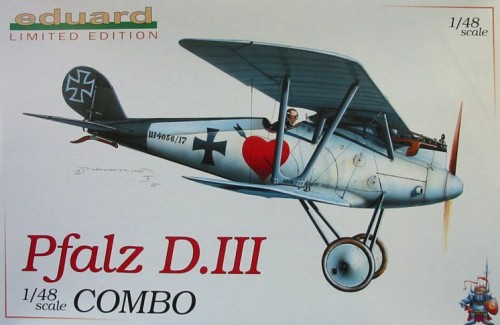
| KIT: | Eduard 1/48 Pfalz D.III 'Limited Edition' |
| KIT #: | ? |
| PRICE: | $39,95 MSRP |
| DECALS: | Six options |
| REVIEWER: | Tom Cleaver |
| NOTES: | Two complete kits; photo etch for one |

| HISTORY |
Pfalz Flugzeugwerke was begun by the three Everbusch brothers before the war to build aircraft under license for the Bavarian government. Prior to the outbreak of the Great War, they acquired the rights to various Morane-Saulnier designs, which resulted in their first success, the Pfalz E.IV monoplane which saw service following the success of the Fokker Eindekker. In 1915, they became a subcontractor to Roland in the production of the C.II and D.II, which allowed them to gain experience with the unique Roland fuselage construction method, which they put to use in Rudolfo Gehringer's D.III, which first appeared in the spring of 1917.
The D.III owed much of it’s basic design philosophy to the Roland fighters Pfalz had been building under license. In look, it was slimmer and even more shark-like than the Roland “fish,” with a semi-monocoque wood ply fuselage. The wings were of unequal chord, which gave a better downward view. Unlike the unfortunate Albatros fighters, Pfalz avoided the structural trap of using the sesquiplane layout by using a two-spar lower wing.
The prototype D.III was tested in June 1917 and quickly went into production with few modifications. Its twin Spandau guns were completely buried in the front fuselage, except for their muzzles, which engendered complaints by the pilots when it went into service because this location made it difficult to clear jams.
The sudden rise to fame of the Fokker Dr.I in the hands of Werner Voss and Manfred von Richtofen eclipsed the Pfalz, but it was nevertheless popular in the rank and file squadrons due to its structural integrity as compared with the Albatros D.V which was the usual alternative for these units. Many lesser-known German aces had a preference for the D.III, particularly Rudolf Berthold for the reason that the throttle was mounted on the stick, which allowed him to fly with a nearly-useless right arm as a result of wounds. From its introduction, it was common among many Jastas for the Pfalz D.II and Albatros D.V and D.Va to be flown together in mixed squadrons, with the result that many German pilots in the latter part of 1917 flew both types alternatively.
The relative robustness of the design of the D.III allowed it to be dived at a higher speed than the Albatros D.V, and a special tailplane with a convex lower surface enabled it to pull out of a fast dive safely. This meant it could be thrown around with relative abandon in combat maneuvering that could result in the Albatros losing a lower wing, and made it very suitable for the dangerous job of balloon busting. It was flown very successfully by Oberleutnant Heinrich Gonterman, who shot down 18 Allied observation balloons.
While the D.III had quick maneuverability which the Albatros D.V lacked, it was nearly 20 mph slower in level flight and was one of the slowest-climbing German scouts, taking seventeen minutes to climb to 10,000 feet. This put it at a great disadvantage when flown against Allied types such as the Camel, SPAD XIII, and the S.E.5a, which reached this altitude in approximately 6 minutes and had a considerable altitude advantage in flight. It was an excellent gun platform and able to absorb more battle damage than any other German scout. The Pfalz D.III achieved wide use due to the general distrust of the Albatros D.V scout and the official abandonment of the Fokker triplane, which meant the D.III was in wider use than either of these prior to the introduction of the Fokker D.VII. By the end of 1917, 276 D.IIIs and 114 improved D.IIIa’s were at the front, with a peak of 436 D.IIIa’s at the front in April 1918, and more than 1,000 were built over its production life. 166 were still in service with secondary Jastas in August and September 1918.
Overall, the D.III was looked on by its pilots as “the best available second choice, and was considered “easy meat” by the average S.E.5a., Camel, and SPAD pilot.
| THE KIT |

 Eduard first released the Pfalz D.III in late 1995, as one of its first
“modern” production versions as the company moved beyond producing
limited-run kits.
Eduard first released the Pfalz D.III in late 1995, as one of its first
“modern” production versions as the company moved beyond producing
limited-run kits.
This is an excellent kit, with great production design leading to a real ease of construction. The design has an easy rigging pattern, which would make it ideal for a modeler who hasn’t yet built a rigged biplane.
What’s particularly nice about this limited edition release is that it includes two complete plastic kits. Photoetch parts for a “profi-pack” version are included for use with one kit, while the other can be built without this. Having done both a “profi-pack” and “non-profi-pack” model from earlier releases of this kit, you can get a great model both ways. With decals for six colorfully-marked D.IIIs, modelers can make some great-looking models. However, you will have to obtain national markings elsewhere to do both kits here, since there are not sufficient national markings decals for both.
| CONCLUSIONS |
Whatever its performance, the Pfalz D.III is one of the best-looking single seat fighters of the war, and is also an historically-important addition to any collection of aircraft of the Great War. Highly recommended.
December 2005
Thanks to Eduard for the review sample.
If you would like your product reviewed fairly and quickly by a site that has nearly 300,000 visitors a month, please contact me or see other details in the Note to Contributors.